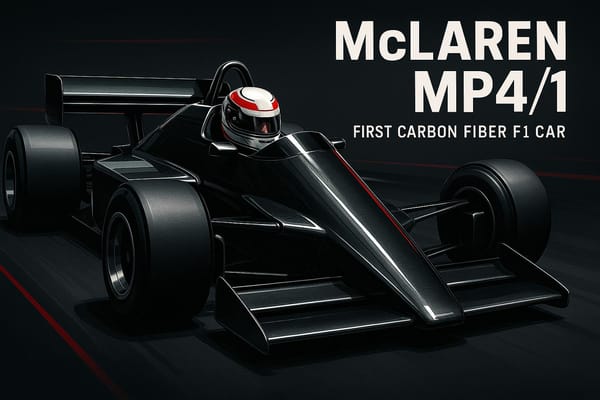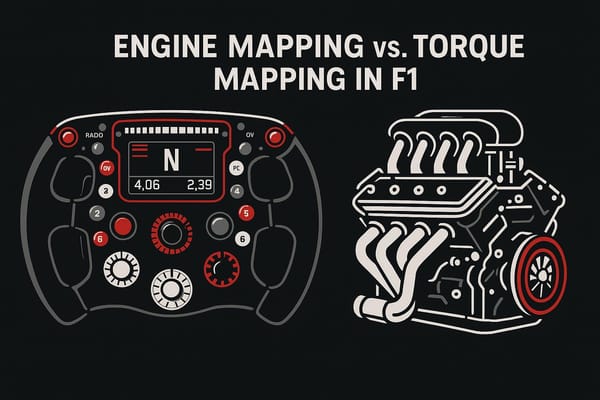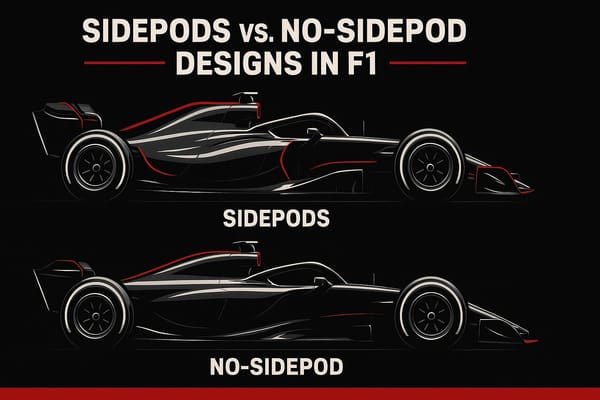Behind the Scenes: What Makes F1 Tracks Unique and Unforgettable
Explore the unique features of F1 tracks that shape racing strategies, driver skills, and the sport's rich history.
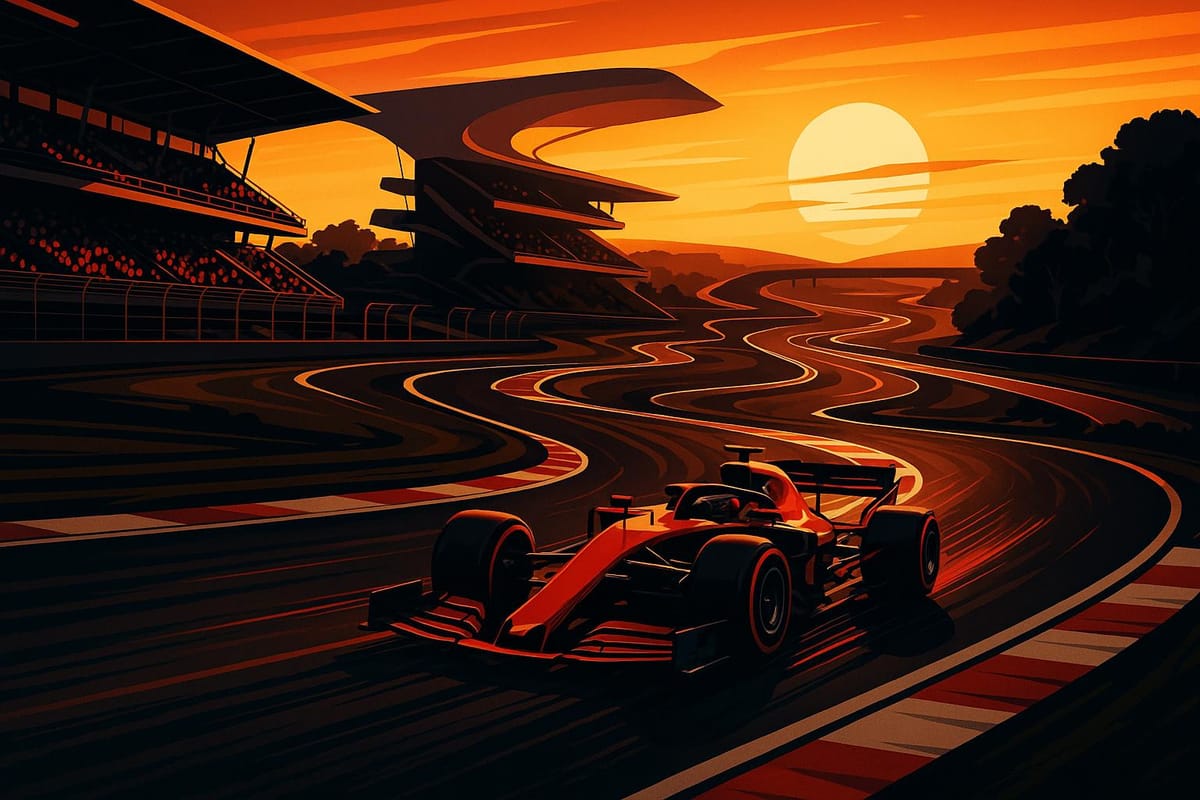
Formula 1 tracks are far more than asphalt circuits - they shape races, challenge drivers, and define the sport's history. Each track has distinct features influencing car setups, strategies, and the overall spectacle. From Monaco's tight, unforgiving streets to Monza's high-speed straights, every circuit demands specific skills and engineering adjustments.
Key takeaways:
- Track Design: Influences overtaking, car setups, and race pace. For example, Spa-Francorchamps' elevation changes test aerodynamics, while Monaco prioritizes precision over speed.
- Weather and Location: Rain, heat, and wind can dramatically alter race outcomes. Tracks like Spa are known for unpredictable rain, while desert circuits like Abu Dhabi test cooling systems.
- Historic Circuits: Tracks like Silverstone and Monza carry decades of racing legacy, blending tradition with modern safety updates.
- Street vs. Permanent Tracks: Street circuits are narrow and bumpy, limiting overtaking, while permanent tracks offer smoother surfaces and varied layouts.
F1 tracks combine technical challenges, environmental factors, and rich history, making every race a unique test of skill and strategy.
How to Design the Perfect F1 Track
Historic Tracks That Built Formula One
Formula One's most iconic tracks didn’t just host races - they helped define the sport itself. These circuits laid the foundation for F1, creating traditions and challenges that resonate even today.
Monaco, Silverstone, and Monza: The Classic Trio

Monaco is often considered the crown jewel of Formula One. First held in 1929, the Monaco Grand Prix is one of the oldest and most prestigious events on the F1 calendar. Its narrow streets and tight corners remain largely unchanged, offering a rare connection to the sport’s past. When drivers like Lewis Hamilton master the Casino Square or Charles Leclerc navigates the iconic hairpin, they’re retracing the paths once conquered by legends like Ayrton Senna and Juan Manuel Fangio.
Silverstone, meanwhile, holds a special place in F1 history as the site of the first-ever Formula One World Championship race in May 1950. Giuseppe Farina’s victory in an Alfa Romeo marked the beginning of modern F1, and the circuit has since been the backdrop for countless unforgettable moments.
Then there’s Monza, affectionately known as the "Temple of Speed." Famous for its high-speed straights and sweeping curves, this track has been a proving ground for F1 technology for decades. Its challenges push the limits of both engine performance and aerodynamic design, making it a favorite for teams and fans alike.
Each of these tracks brings its own unique demands to the table. Monaco tests a driver’s precision and nerves, Silverstone calls for adaptability and strategic thinking, and Monza rewards pure speed and engineering prowess. Together, they showcase the diverse skills and strategies required to succeed in Formula One, forming the backbone of what makes the sport so captivating.
How Classic Tracks Have Evolved
Over the years, these historic circuits have undergone changes to balance their original character with modern safety requirements. The 1960s marked a turning point, as safety became a priority. Improvements like pitlane speed limits and advanced run-off areas have reshaped these tracks while striving to maintain their essence.
One significant advancement has been the introduction of asphalt run-off zones, which are twice as effective at slowing cars during accidents compared to traditional gravel or grass. For example, when Zandvoort rejoined the F1 calendar in 2020, it incorporated extensive updates, including gravel run-offs, to meet modern safety standards.
However, these changes haven’t always been met with enthusiasm. Jackie Stewart, a vocal advocate for safety reforms, once noted the resistance he faced:
"My quest for safety had become by far the most unpopular thing that I was faced with. I don't think there's a single corner of any race track in the world called Stewart corner."
Despite the controversies, these updates have allowed historic tracks to remain central to the F1 experience. Many of these circuits were originally carved out of public roads or shaped by natural terrain, giving them a unique charm. Street circuits, in particular, demand near-flawless precision as drivers navigate tight barriers with little margin for error.
What keeps these tracks so beloved is their ability to challenge drivers while preserving a link to F1’s roots. They’ve adapted to modern safety standards without losing the characteristics that make them legendary. These updates not only honor the sport’s history but also pave the way for the technical advancements that continue to define Formula One today.
Technical Elements That Set F1 Tracks Apart
F1 circuits are more than just roads - they're intricate designs that challenge teams and drivers in unique ways. These technical elements are often the reason some tracks suit specific teams or driving styles better than others.
Street Circuits vs. Permanent Tracks
The difference between street circuits and permanent tracks goes far beyond location. Street circuits are temporary setups on public roads, while permanent tracks are purpose-built facilities designed for racing.
This distinction creates vastly different racing conditions. Street circuits are known for slower speeds, limited overtaking opportunities, frequent safety car deployments, and severe consequences for driver errors. A single misstep on these narrow, bumpy roads can end a race instantly. In the 2023 F1 season, seven of the 23 races were held on street circuits, underscoring their increasing role in the championship.
Street circuits also pose unique challenges for car setups. Since they use public roads, the surfaces are often uneven and bumpy, making it harder for teams to find the right balance. Drivers must rely on split-second decisions under immense pressure, as barriers leave little room for error.
Permanent tracks, on the other hand, offer a different kind of test. These tracks feature smooth, consistent surfaces and layouts that include long straights, wide corners, and technical sections. The design allows for easier overtaking and gives teams more flexibility to fine-tune their cars for a mix of speed and handling.
| Aspect | Street Circuits | Permanent Tracks |
|---|---|---|
| Surface Quality | Uneven, bumpy public roads | Smooth, consistent surfaces |
| Layout Constraints | Limited by road infrastructure | Purpose-built for racing |
| Overtaking | Difficult due to narrow width | Easier with long straights |
| Safety Features | Tight barriers, minimal run-offs | Ample run-off areas, safer zones |
| Car Setup | High downforce for tight turns | Balanced for speed and control |
Key Features of Famous Tracks
Each circuit has its own personality, shaped by unique technical features that test even the best drivers. One standout challenge is elevation changes, which affect everything from aerodynamics to tire wear.
Take Spa-Francorchamps, for instance. This legendary track features the steepest elevation change in Formula One, with a 102-meter difference between its highest and lowest points. The iconic Raidillon de l'Eau Rouge section compresses cars with forces up to 3g, requiring teams to adjust the front ride height to handle the strain.
"You never know what's the limit. And you'll never love to find out the limit. Because at that point you're too late and you're already in the wall."
Track width also plays a huge role in racing dynamics. Narrow circuits like Monaco make overtaking nearly impossible, while wider tracks allow for multiple racing lines and more passing opportunities. Corner types add further complexity - hairpins demand sharp braking and quick acceleration, while chicanes test a car's agility in rapid direction changes.
Elevation changes, like Portimão's dramatic 16-meter drop at Turn 11, require teams to rethink suspension settings and tire pressures. These adjustments are crucial for handling the unique demands of hilly tracks compared to flat ones.
All these elements combine to give each circuit its own identity. They explain why certain teams and drivers excel at specific tracks, shaping race strategies and influencing the outcome of every Grand Prix.
How Location and Weather Shape Racing
Racing isn’t just about speed and skill - it’s also about adapting to the unique challenges presented by geography and weather. The terrain and climate of each race location play a huge role in shaping track designs and influencing race strategies. Whether it’s the dense forests of Belgium or the sun-scorched deserts of Abu Dhabi, every track brings its own set of hurdles for teams and drivers. Let’s take a closer look at how these factors impact racing.
Tracks Defined by Their Location
A circuit’s location often dictates its character and challenges. Take the Circuit de Spa-Francorchamps in Belgium, for example. Nestled in the Ardennes forest, this track is famous for its dramatic elevation changes and sweeping turns, offering drivers a mix of uphill battles and downhill thrills.
Urban circuits are a completely different beast. These tracks repurpose public roads, creating a unique atmosphere with their tight turns and close barriers. The Miami Grand Prix, for instance, had to contend with noise concerns raised by local activists, which ultimately led to adjustments in its location.
Then there’s the Yas Marina Circuit in Abu Dhabi. Known for its twilight races, this track combines long straights, sharp corners, and sweeping curves, all set against a stunning desert backdrop. The desert climate adds another layer of complexity, with teams needing to account for the unique environmental conditions.
Terrain also plays a pivotal role in how tracks are designed. The Circuit of the Americas in Austin, Texas, is a perfect example. It incorporates tight hairpins, fast curves, and long straights, all while taking full advantage of the rolling Texas hills. These natural features make each lap a test of both driver skill and engineering precision.
Weather's Impact on Race Strategy
If the terrain shapes the track, the weather dictates how races unfold. Conditions like rain, temperature, and wind can turn strategies on their heads, often deciding the race’s outcome [15]. Temperatures during race weekends can swing wildly - from a chilly 41°F (5°C) to a blistering 108.5°F (42.5°C).
Extreme heat is a grueling test for both drivers and their machines. Inside the cockpit, temperatures can soar to 122–140°F (50–60°C), causing drivers to lose up to 4.4–6.6 pounds through sweat during a race. This kind of heat can lead to mental fatigue and slower reaction times, while cold weather can make steering more physically demanding.
Teams rely heavily on weather forecasts to fine-tune their strategies. In scorching conditions, they might opt for harder tires to extend tire life or adjust pit stops to prevent overheating [15]. Extra cooling measures, like opening vents, can help protect the car but may come at the cost of aerodynamic efficiency.
Cooler weather has its own quirks. Softer tires are often chosen to maximize grip on cold tracks, though they wear out faster [15]. Interestingly, cooler air can slightly improve engine performance, giving teams a small but useful edge.
Rain, however, is the ultimate game-changer. Wet tracks reduce grip, increase braking distances, and make corner exits trickier. To cope, teams might increase wing angles to boost downforce and keep the car stable. The 2022 Japanese Grand Prix is a prime example of how rain can disrupt a race. Torrential rain caused a red flag after just two laps, delaying the restart. Despite the chaos, Max Verstappen’s skill in wet conditions helped him secure the World Championship that day.
"Growing up in Belgium and Holland, it rains a lot. So, we never like turned around when it suddenly started raining. We would put the rain tires on and we would go and practice and that just helps a lot. You get a lot more understanding of what you have to do when it rains."
– Max Verstappen
Wind is another unpredictable factor. While tailwinds can boost straight-line speed, crosswinds can destabilize cars and make braking more challenging. Teams constantly monitor wind patterns and adjust car setups to minimize disruptions [15].
In Formula 1, every millisecond counts. While engineering and preparation are crucial, weather remains the great equalizer. The ability to adapt quickly to changing conditions often separates the good teams from the truly exceptional ones [15].
Track Design and Race Strategy
A Formula 1 track isn't just a collection of turns and straights - it’s the blueprint that dictates how teams approach every aspect of a race weekend. From aerodynamics to tire choices, fuel strategy to pit stops, track design is at the heart of every decision. And with such diverse circuits on the calendar, the challenges vary dramatically.
How Different Track Types Create Different Challenges
Formula 1 tracks fall into distinct categories, each posing unique demands on teams and drivers. Power tracks like Monza emphasize straight-line speed, while high downforce circuits prioritize cornering ability and precision.
Take Monza, for example. Known as the "Temple of Speed", drivers spend 75% of the lap at full throttle, making it a battlefield for engine performance and slipstream tactics. In 2020, Lewis Hamilton showcased this when he set the record for the highest average speed over a single lap - 164.267 mph (254.362 km/h). To excel here, teams strip downforce to the bare minimum, sacrificing cornering grip to maximize straight-line speed.
In contrast, high downforce tracks flip the script. These circuits feature fewer straights and more technical corners, pushing teams to prioritize aerodynamic grip. The setups here focus on maximizing cornering speed, even at the cost of top-end velocity.
Street circuits, like Monaco, add another layer of complexity. Unlike permanent tracks with forgiving run-off areas, street circuits leave no room for error - concrete barriers are just feet away. These unforgiving conditions demand precision driving and razor-sharp focus.
Track surface also plays a pivotal role. Variations in texture and composition can dramatically affect tire wear and grip, forcing teams to adjust strategies in real time. The 2020 Turkish Grand Prix is a perfect example: a newly resurfaced track with minimal grip threw teams into chaos, as they scrambled to adapt their strategies to the challenging conditions.
"All drivers have a subtly different approach to driving an F1 car, and the fastest drivers tend to be the ones who can adapt their style every week to get the best performance out of their car in the unique circumstances presented by each track." - Joe Holding, Formula 1
Data analysis becomes the cornerstone of strategy. Teams rely on real-time data to monitor tire degradation, fuel consumption, and aerodynamic performance, making constant adjustments to maintain the perfect balance between speed and durability.
Monaco, Silverstone, and Miami Compared
To understand how track design shapes strategy, let’s compare three iconic circuits: Monaco, Silverstone, and Miami. Each offers a completely different challenge, requiring teams to tailor their approach.
| Aspect | Monaco | Silverstone | Miami |
|---|---|---|---|
| Track Type | Street circuit | Permanent facility | Temporary street circuit |
| Key Characteristics | Tight confines, bumps, manhole covers | Fast, open layout; one of the longest | 19 corners, 3 straights, elevation changes |
| Overtaking Opportunities | Almost none | Multiple overtaking zones | Moderate opportunities |
| Margin for Error | Zero margin for error | Generous run-off areas | Some margin for error |
| Strategic Focus | Precision and concentration | High-speed stability and endurance | Technical driving and elevation management |
| Historical Significance | On the calendar since 1950 | Hosted the first F1 World Championship race in 1950 | Newest addition, designed to feel permanent |
Monaco is the ultimate test of precision. Its narrow streets, surface irregularities, and lack of overtaking opportunities make qualifying performance critical. With no margin for error, it’s about threading the needle lap after lap.
"Monaco is bigger than just race day." - Max Payne
Silverstone, on the other hand, is all about speed and endurance. Its roots as an airfield are evident in its fast, flowing layout, which rewards aerodynamic efficiency and bold driving. As one of the longest tracks on the calendar, it’s a true test of both car reliability and driver stamina.
Miami, one of the newest additions, brings modern engineering to the forefront. The Miami International Autodrome features a mix of technical corners, elevation changes, and long straights. The Turn 14-15 chicane, with its uphill climb and rapid descent, highlights the circuit's complexity. The sequence from Turn 13 to Turn 16 is particularly challenging, weaving around ramps and under flyovers while adhering to strict FIA clearance regulations.
"This whole sequence was a real engineering challenge. We're right on the limitations of design in this area. In this location, we're having to install the debris fence from behind the barrier because there is no room to lift the debris fence over the barrier." - Andrew Wallis, Apex project lead design engineer
These three circuits - Monaco, Silverstone, and Miami - underscore the diversity of Formula 1. Each demands a completely different approach, from Monaco's precision-focused strategy to Silverstone's emphasis on speed and Miami's technical challenges. Success in Formula 1 comes from mastering these unique demands, week in and week out.
Conclusion: What Makes F1 Tracks Memorable
The most iconic Formula 1 tracks stand out for three key reasons: their rich history, ingenious design, and an electrifying atmosphere that captivates both drivers and fans. These elements come together to create circuits that transcend mere racing venues, becoming legendary stages where motorsport history is written.
Historical significance anchors the legacy of these tracks. Circuits like Monaco, Silverstone, and Monza have seen defining moments that shaped Formula 1’s story. Their continued presence on the calendar connects the sport’s golden age with its modern evolution, allowing today’s drivers to race on the same hallowed ground where legends like Ayrton Senna and Jim Clark once triumphed.
The design and technical challenges of these tracks elevate them beyond ordinary circuits. Suzuka, with its unique figure-eight layout, remains a standout in Formula 1, demanding flawless precision and rhythm from drivers. Meanwhile, Spa-Francorchamps, with its sweeping corners and dramatic elevation changes, pushes cars to their limits, testing everything from aerodynamics to tire management.
But it’s not just about the layout - it’s the fan atmosphere that breathes life into these tracks. The energy from passionate spectators transforms great circuits into unforgettable experiences. At Suzuka, for example, Japanese fans pack the grandstands in overwhelming numbers, even when no local driver is competing. Their enthusiasm creates an electric environment that resonates with drivers and teams alike, turning race weekends into cultural events that extend far beyond the track. This passion is reflected in metrics that consistently highlight Suzuka’s exceptional atmosphere.
"A circuit designed by the gods" - Sebastian Vettel on Suzuka
The data backs it up: circuits like Suzuka frequently earn top marks for both atmosphere and layout, while Spa-Francorchamps excels across atmosphere, layout, and racing quality.
Even as these tracks adapt to modern safety standards, they retain their essence. For instance, while Suzuka’s legendary 130R corner has evolved to meet safety requirements, it still presents a formidable challenge for drivers. This balance between tradition and innovation ensures these circuits remain timeless, serving as both a tribute to Formula 1’s heritage and a stage for its future strategies and breakthroughs.
FAQs
How do F1 track designs shape team strategies and car setups during race weekends?
F1 track designs have a massive impact on how teams approach both their strategies and car setups. Take Monza, for instance - a circuit famous for its long straights. Here, teams focus on maximizing top speed by using low-drag aerodynamic setups. On the other hand, tracks like Silverstone, filled with fast, sweeping corners, demand a more balanced setup to ensure stability and grip at high speeds.
Tire strategies are another critical factor, shaped by the track’s surface and layout. Rougher surfaces or tracks with lots of braking zones can lead to higher tire wear. In these cases, teams must carefully choose tire compounds and fine-tune pressures to keep performance consistent throughout the race. By customizing car setups to meet the specific challenges of each circuit, teams work to strike the perfect balance between speed and durability, giving themselves the best shot at victory.
How does weather impact F1 races, and how do teams adapt to changing conditions?
The Impact of Weather on Formula 1
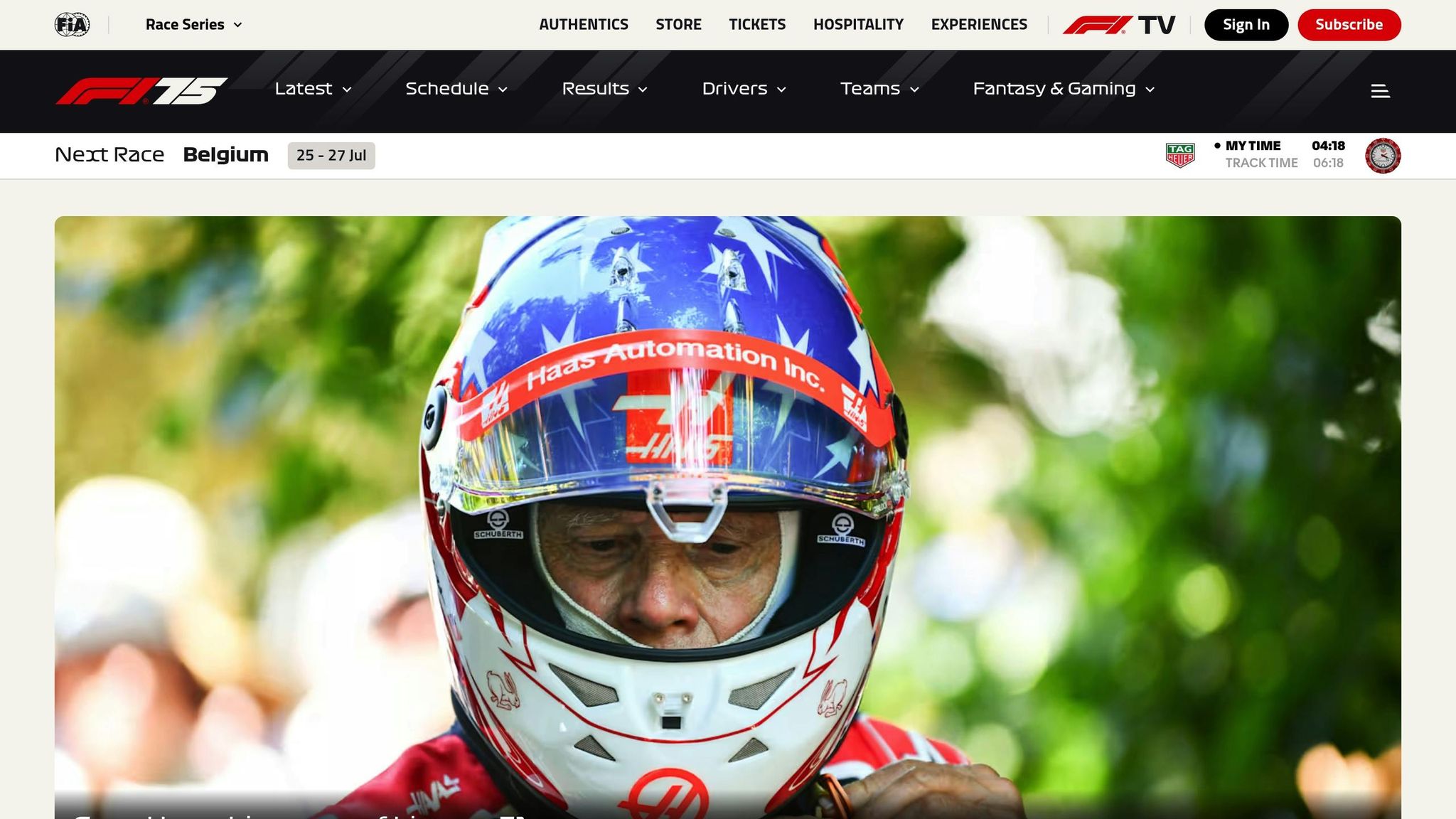
Weather has a huge impact on Formula 1, affecting everything from tire performance to track conditions and even driver visibility. Whether it’s scorching heat, sudden rain, or unpredictable temperature swings, teams must adapt on the fly to stay competitive.
Take hot weather, for example. High temperatures can cause tires to overheat, leading to faster wear and forcing teams to rethink their pit stop strategies. On the flip side, rainy conditions dramatically reduce grip and visibility, requiring drivers to switch to wet tires and adjust their driving techniques to avoid mistakes.
To prepare for these challenges, teams focus on fine-tuning their car setups. This might involve tweaking aerodynamics, adjusting suspension settings, or keeping a close eye on weather forecasts to make critical, last-minute decisions during the race.
In the end, the ability to predict and react to shifting weather conditions often separates the winners from the rest of the pack.
What makes historic F1 tracks like Monaco, Silverstone, and Monza so iconic?
Historic Formula 1 Circuits
Tracks like Monaco, Silverstone, and Monza are more than just venues - they're the heartbeat of Formula 1, steeped in history and tradition. Monaco, with its tight, twisting streets, has been a jewel in the F1 crown since 1929. Its layout demands precision and nerves of steel, offering drivers one of the most challenging and glamorous experiences in motorsport.
Silverstone, known as the 'Home of British Motor Racing,' holds a special place in F1 lore. It was here in 1950 that the first-ever F1 World Championship race took place, forever linking the circuit to the sport’s origins. Then there’s Monza, a temple of speed that has thrilled fans since 1950. Its long straights and the roaring enthusiasm of the tifosi create an electric atmosphere unmatched anywhere else.
What sets these circuits apart isn’t just their history but their distinctive designs. Each track pushes drivers to their limits in different ways, shaping race strategies and delivering unforgettable moments. Year after year, they remain a source of awe for fans and a true test for competitors, embodying the spirit of Formula 1.
Related posts
- Monaco Grand Prix Circuit Guide: The Prestige, Precision, and Pressure of F1’s Crown Jewel
- Albert Park Uncovered: The History, Evolution, and Challenges of the Australian Grand Prix Circuit
- 5 Iconic F1 Tracks You Must Visit for the Ultimate Racing Experience
- How F1 Tracks are Designed: The Art and Science Behind the Curves

